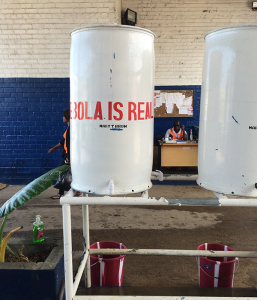After “patient zero” contracted Ebola in Guinea in 2013, the disease quickly spread to Liberia and Sierra Leone, becoming the deadliest occurrence of the virus since it was discovered in 1976. Declared an international public health emergency, the outbreak ravaged already weakened health systems in the three most affected countries, further eroded trust in these systems, and posed a serious public health risk, both regionally and globally. Since Ebola spreads quickly within families and in healthcare settings, it was crucial to address the epidemic using methods such as rapid case identification, quick referral for treatment and quality case management. Additional elements of a successful response included meticulous contact tracing, epidemiological surveillance, improved sanitation and hand washing behaviors, safe burials, and training of service providers in infection prevention and control.
The Role of Social and Behavior Change Communication in the Ebola Response
While a combination of these elements eventually helped lessen the spread in West Africa, none of these would have worked without significant changes in behaviors and social norms. During the epidemic, deeply entrenched, culture-altering changes occurred in a matter of not months or years — but weeks.
This would not have happened without social and behavior change communication (SBCC) interventions.
SBCC was integrated into the response to address behavior-related issues, such as dignified and safe burials, case identification and contact tracing, and early care and treatment. Dedicated community engagement and community-identified solutions were among the approaches that worked.
Below is a timeline of the epidemic, including global milestones interspersed with the work of the Health Communication Capacity Collaborative (HC3) teams in Liberia and in the United States. With active cases in Guinea and in Sierra Leone and the return of EVD to Liberia in June, our work continues. The aim of this timeline is to reflect on the trajectory of the crisis and demonstrate how social mobilization and effective messaging led toward an Ebola-free Liberia as well as the development of preparedness plans for future outbreaks.

